Volume 42 Number 3 (2011.9)
Special Feature
Nanostructured Materials
Part I. Special Feature
Overview
Review
-
2. Synthesis and Modification of Silicon Nanosheets
 (893kB)
(893kB)pages 1-7
Hideyuki Nakano and Hirotaka Okamoto
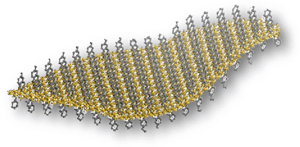
A variety of silicon nanosheets (SiNSs) and organo-modified SiNSs are reviewed. These nanosheets were prepared by a soft synthesis method, and with chemical surface modification in a solution-based process. Characterization revealed very high two-dimensional anisotropy for the nanosheets; with a thickness of around 1 nm vs. a lateral size of a few submicrometers.
Research Reports
-
3. Synthesis and Characterization of Microstructure-controlled Carbon Nanotubes
 (1,222kB)
(1,222kB)pages 9-18
Atsuto Okamoto, Itaru Gunjishima, Takashi Inoue, Riichiro Ohta and Koichi Nishikawa
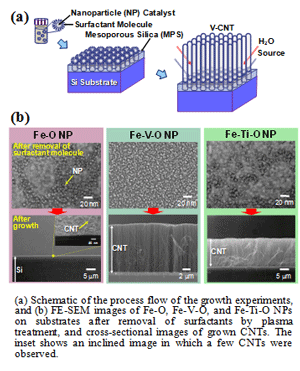
Vertically aligned carbon nanotubes (V-CNTs) with controlled diameter, and nitrogen-containing CNTs (NCNTs) were prepared by a catalytic chemical vapor deposition method using highly active and size-classified nanoparticles, and a nitrogenation process with pretreatment by ultraviolet light irradiation, respectively. The thermal and electrical conduction properties of V-CNTs were evaluated, in addition to the chemical bonding states of the NCNTs, and the electrical conductivity of NCNT yarns. -
4. Visible-light Emission from Dye-doped Mesostructured Organosilica Hybrid Films
 (972kB)
(972kB)pages 19-26
Norihiro Mizoshita, Yasutomo Goto, Yoshifumi Maegawa, Takao Tani and Shinji Inagaki
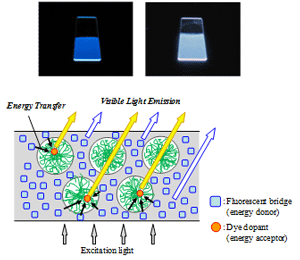
Highly fluorescent organosilica mesostructured films were prepared by surfactant-directed self-assembly of organosilane precursors with blue-fluorescent oligo(phenylenevinylene) or tetraphenylpyrene bridging moieties. Doping of the blue-light-emitting mesostructured films with different fluorescent dyes resulted in efficient fluorescence emission over a wide range of the visible spectrum through Forster resonance energy transfer from the organosilica frameworks to the doped dyes.
-
5. Novel Photocatalysts Based on Periodic Mesoporous Organosilica
 (2,642kB)
(2,642kB)pages 27-34
Takao Tani, Hiroyuki Takeda, Masataka Ohashi and Shinji Inagaki
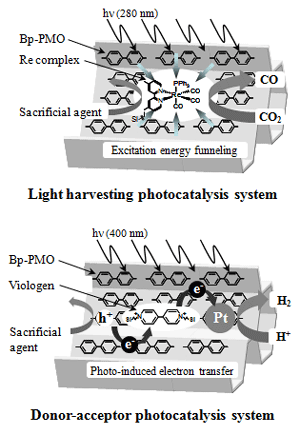
We constructed two types of novel photocatalysts utilizing light harvesting or photo-induced electron donating properties of periodic mesoporous organosilica (PMO). They were found to exhibit photocatalytic CO2 reduction or hydrogen evolution by light irradiation. These findings demonstrated the potential of PMO for construction of various photocatalysts by appropriate combination of the organic groups in the framework and catalysts in the mesochannels. -
6. Au Nanoparticle-embedded Core/shell Mesoporous Silica Spheres
 (896kB)
(896kB)pages 35-45
Hitoshi Kumagai, Tadashi Nakamura and Kazuhisa Yano
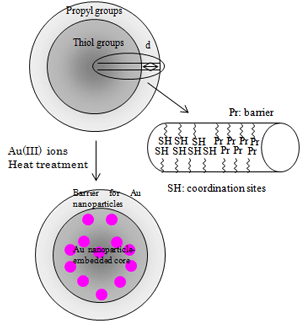
A series of organically functionalized core/shell monodispersed mesoporous silica spheres (MMSSs) were synthesized and characterized as host materials for Au nanoparticles. Au nanoparticles were retained within the core after heat treatment due to the steric hindrance and hydrophobic character of the propyl groups.
Part II. Highlighted Papers
Research Reports
-
7. Development of a New Breath Alcohol Detector without Mouthpiece to Prevent Drunk Driving
 (514kB)
(514kB)pages 47-51
Toshiyuki Taguchi, Kiyomi Sakakibara, Atsushi Nakashima, Toshihiro Wakita, Shohei Yabu and Bunji Atsumi
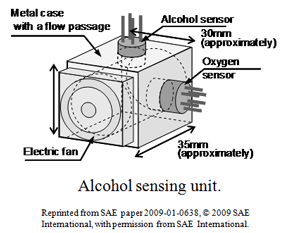
Contact free alcohol detector, which doesn’t require a mouthpiece, has been developed as a tool available on board. It consists of an alcohol sensor and an oxygen sensor mounted in a gas flow passage. The fluctuations of the alcohol signals caused by air mixing are extremely reduced by the calibration of alcohol concentration using an oxygen level.
-
pages 53-62
Naohiko Kato, Kazuo Higuchi, Hiromitsu Tanaka, Junji Nakajima, Toshiyuki Sano and Tatsuo Toyoda
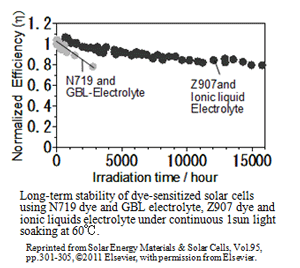
We have clarified the deterioration of the electrolyte based on γ-butyrolactone (GBL) of dye-sensitized solar cells module after the outdoor working condition for ∼2.5 years. Using the solvent-free ionic liquids electrolyte, the stability of the DSC was improved exceedingly, compared with the GBL electrolyte. The life time for outdoor use was estimated over 15 years from acceleration factor based on the outdoor exposure test. -
9. Nanocomposite of Al2O3 and ZrO2-TiO2 as a Support for NOx Storage-reduction Catalyst
 (780kB)
(780kB)pages 63-70
Haruo Imagawa
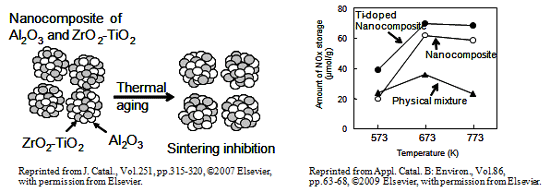
The synthesis and application of a novel nanocomposite of γ-Al2O3 and ZrO2-TiO2 (AZT) as a support for a NOx storage-reduction catalyst are reviewed. AZT inhibited sintering of ZrO2-TiO2 particles after thermal aging, due to the diffusion barrier created by γ-Al2O3. Ti doping of AZT enhanced sulfur durability owing to lower basicity, which contributed to excellent NOx storage performance.
-
pages 71-85
Hiroaki Minoura
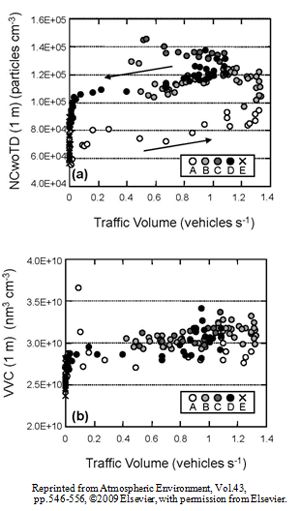
Traffic volume and correlation with particle number concentration at 1m height (NCwoTD; upper) and particle volume of volatile component (VVC; lower). A-E shows time zones in one signal cycle. VVC showed a linear relationship with the volume of traffic showed an increase in VVC in proportion to the total amount of vehicle exhaust. On the other hand, since a nucleation process changed in response to the influence of the state of the gas and condensable nuclear precursor in the atmosphere, number concentration showed hysteresis.
